How to Store a Chainsaw So It Doesn’t Leak Oil
- January 29, 2024
- 0 comment
Discovering your chainsaw has leaked oil can be a frustrating experience. Not only does it create a mess, but it also signifies the wastage of valuable oil and potentially hints at underlying issues with your chainsaw. This comprehensive guide offers a myriad of strategies to ensure your chainsaw is stored correctly, thereby preventing oil leaks and preserving the longevity and performance of your equipment.
Understanding the Issue
Chainsaw oil leaks are a prevalent issue, plaguing even the top-tier models. The oil, vital for the smooth operation of the chainsaw, can seep out when the saw is not in use, leading to messy spills and unnecessary expenses. As such, mastering the art of proper chainsaw storage is crucial.
Storing a chainsaw properly is not just about finding a spot in the garage or shed. It’s about ensuring that when you next need the chainsaw, it’s ready to go, leak-free, and well-maintained. Every chainsaw enthusiast has faced the challenge of oil leaks during storage. To mitigate this, here are comprehensive steps to store your chainsaw and prevent those pesky oil leaks.
Before Storing your Chainsaw
1. Empty of Oil Before Storing
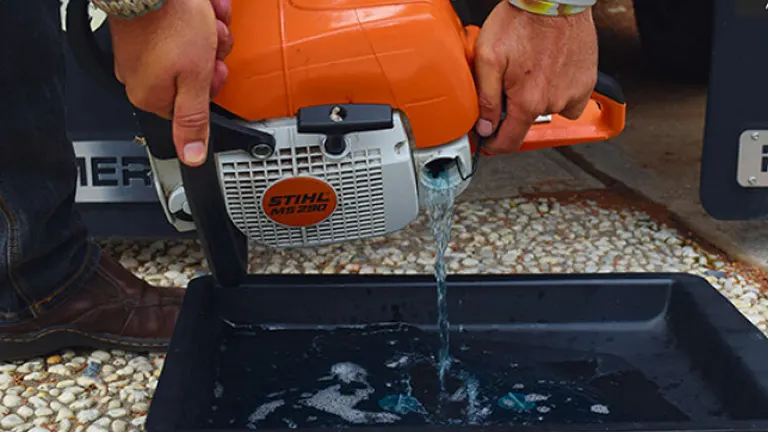
If your chainsaw use is seasonal (e.g., cutting logs for winter), ensure to drain the remaining fuel and oil from the tank at the end of the season. This prevents oil leaks and protects the engine from potential damage due to stagnant fluids.
2. Check the Oil Line
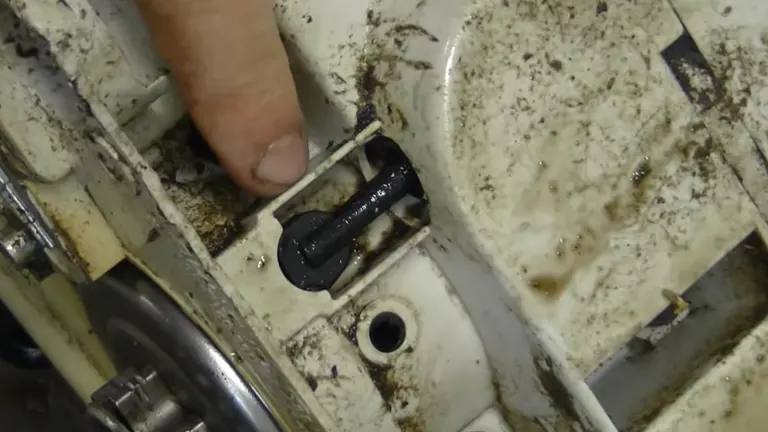
Regularly inspect the oil line, which feeds bar oil from the oil tank to the oil pump. Visible leaks or ruptures can lead to oil build-up and eventual leakage. Replace the line if necessary to ensure a tight, leak-proof system.
3. Don’t Overfill the Chainsaw’s Oil Storage Tank
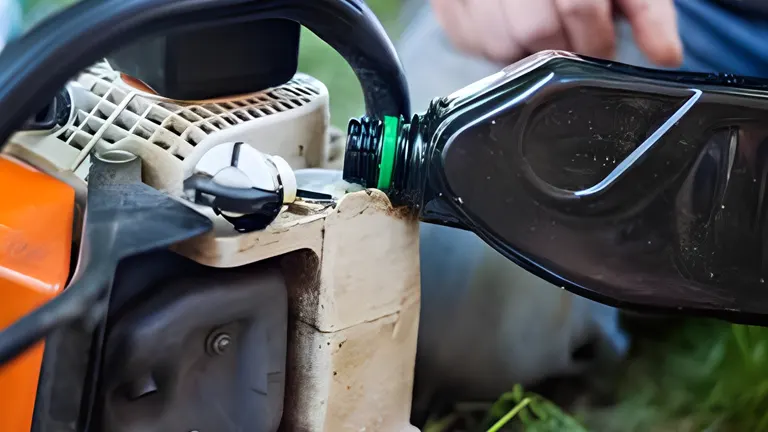
Be mindful of the oil storage tank’s capacity. Avoid overfilling, as oil expands with temperature changes. Overfilling can lead to leaks, especially in uninsulated storage areas. Aim to keep the tank no more than two-thirds full.
4. Ensure the Oil Plug is Functional
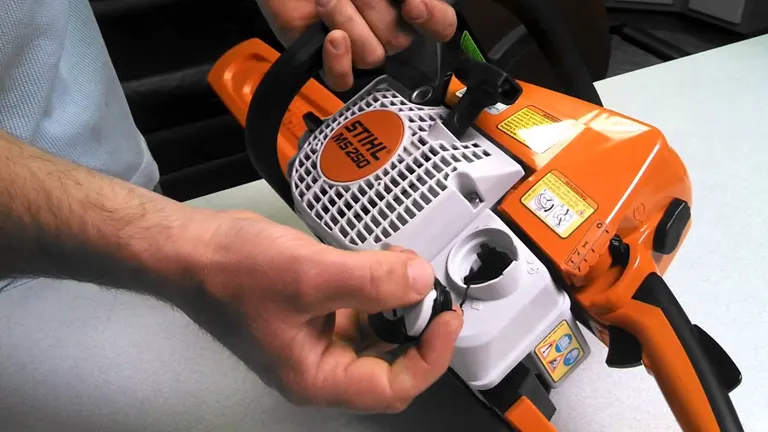
The oil plug can degrade and misshape over time, leading to a broken seal and potential leaks. Regularly inspect and replace the plug as needed. They are typically inexpensive and available from your chainsaw’s original supplier.
5. Protect Against Leaks
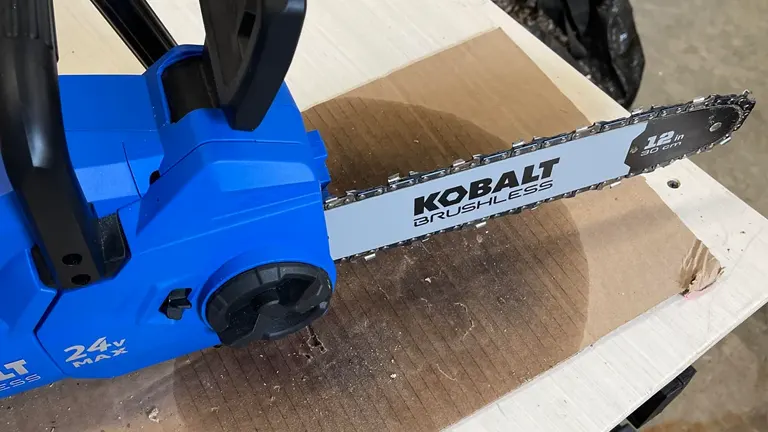
As a precaution, store your chainsaw on a piece of absorbent material, like cardboard, to catch any unexpected drips and make clean-up easier.
Chainsaw Hanging Techniques
6. Hang the Chainsaw by Rear Handle
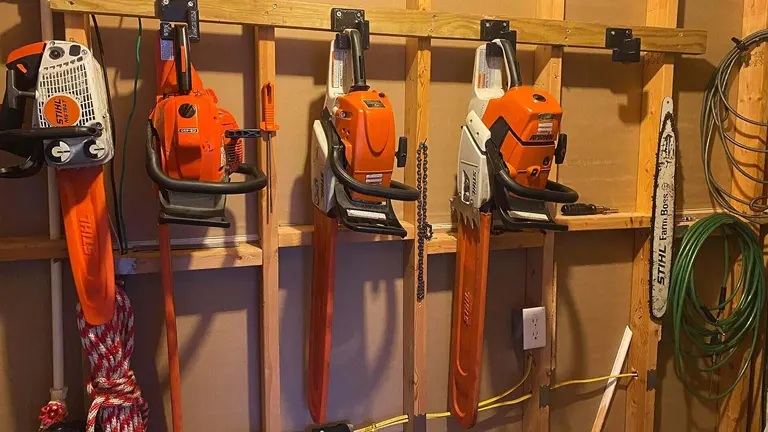
Hanging the chainsaw by the rear handle is a space-saving storage method. However, ensure to drain the oil beforehand to prevent leakage.
7. Hang the Chainsaw Vertically
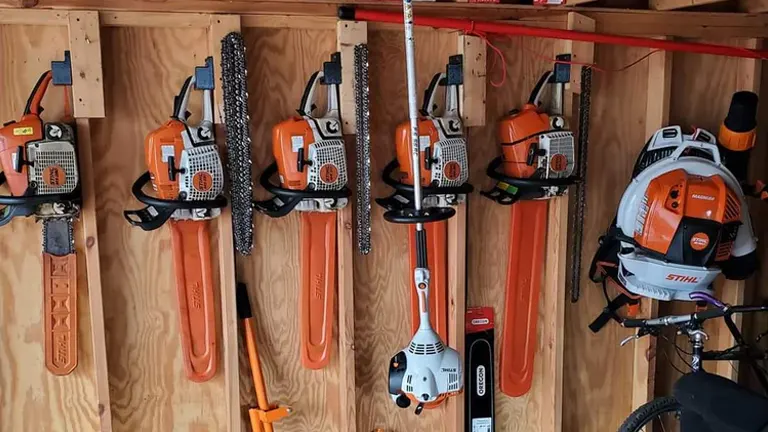
Hanging the chainsaw vertically can sometimes lead to oil leaks due to built-up pressure in the tanks. To avoid this, drain the oil before storage or “burp” the tanks to release built-up pressure.
8. Hang the Chainsaw by Brake Stop
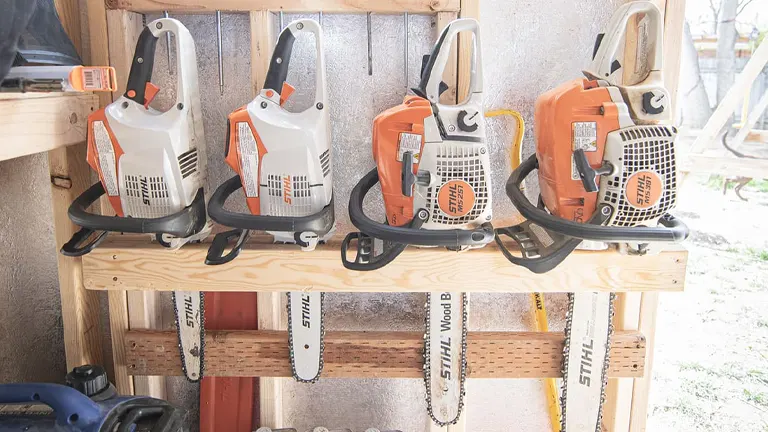
Hanging by the brake stop handle is another option, though it’s less suitable for heavy chainsaws. Ensure the handle is robust enough to support the weight of your chainsaw without causing damage or increasing the risk of oil leaks.
Maintenance and Cleaning
9. Always Keep the Outlets Clean
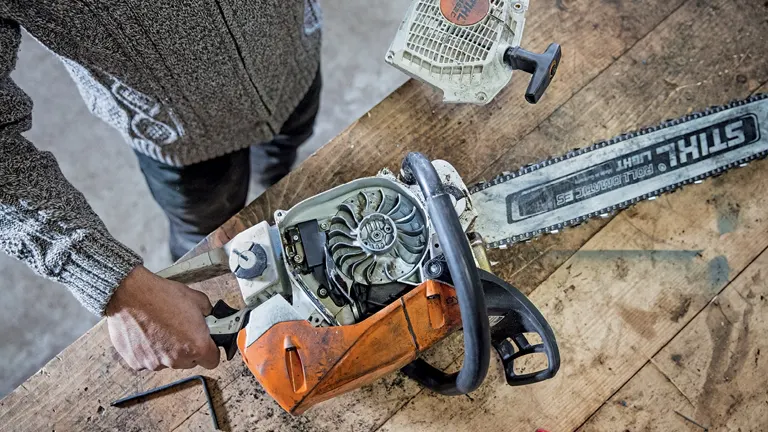
Regularly clean the chainsaw’s outlets, especially if you notice sawdust build-up. Clogged outlets can lead to increased pressure in the oil system, resulting in leaks.
10. Never Store a Chainsaw on Its Sides
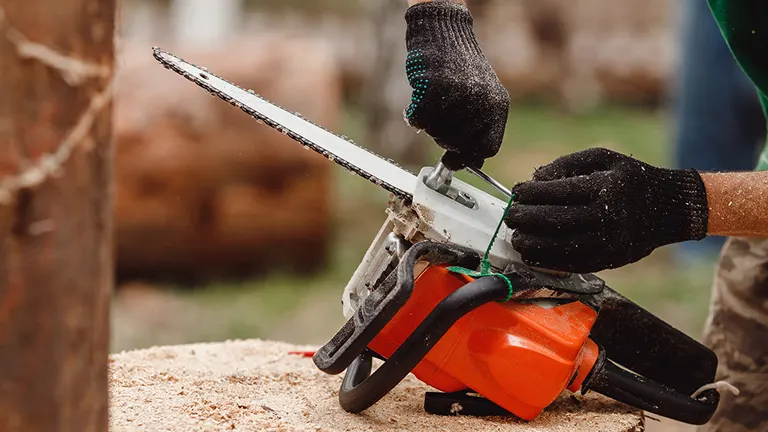
Storing a chainsaw on its sides can align the oil tank openings in a way that encourages leaks. Opt for a flat, stable surface or consider the hanging options mentioned earlier.
11. Check Your Tool for Mechanical Problems Before Storage
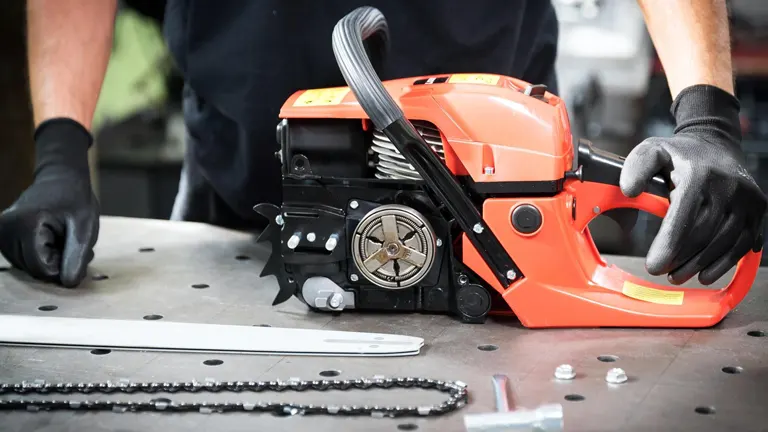
Conduct a comprehensive mechanical check before storing your chainsaw. Addressing any issues beforehand can prevent leaks and ensure your chainsaw is ready for action when you next need it.
By integrating these practices into your chainsaw storage routine, you can significantly reduce the likelihood of encountering oil leaks. This not only keeps your storage area clean but also preserves the integrity and performance of your chainsaw, ensuring it remains a reliable tool for your tasks.
Additional Tips for Short-Term Storage
- Use a sheath or cover to protect the chainsaw.
- Store the chainsaw in a cool, dry place.
- Consider using silicone spray to prevent leaks, though this is optional.
- Regular use can help maintain the chainsaw’s condition.
- If leaks persist, store the chainsaw in a plastic bag to contain the mess.
Is It Normal for Chainsaws to Leak Oil?
While minor oil leaks can be relatively common in chainsaws, they should not be ignored. A few drops of oil noticed under a stored chainsaw may not signal a significant problem; it can be a residual oil escaping from the guide bar after use. However, regular and significant leaks are not normal and typically indicate an issue that requires attention. Factors such as a perished oil line, a compromised oil tank seal, or a malfunctioning oil pump can lead to excessive oil leakage. Identifying and rectifying these issues promptly can save you from future complications and ensure the efficient operation of your chainsaw.
Do Electric Chainsaws Leak Oil?
Electric chainsaws, despite their different power mechanism, are not exempt from the issue of oil leaks. Like their gas-powered counterparts, they require bar oil for lubrication of the chain during operation, which can lead to potential leaks if not managed properly. The causes of oil leaks in electric chainsaws mirror those in gas-powered models, including overfilling the oil reservoir, inadequate ventilation, or damage to the oil delivery system. Regular inspection, proper filling, and appropriate storage are vital steps in preventing oil leaks in electric chainsaws. Addressing these aspects diligently ensures a clean, efficient, and ready-to-use chainsaw for your cutting needs.
By embracing a routine of thorough inspection, maintenance, and understanding the intricacies of your chainsaw, whether gas-powered or electric, you can significantly mitigate the risk of oil leaks and maintain your tool in prime condition, ready to tackle the tasks at hand without the inconvenience of unexpected oil spills.
Related Articles:
- How to Install Chain on Chainsaw+
- How To Start A Stihl Chainsaw Step By Step: A Complete Guide
- Chainsaw Log Peeler Review
- Why Were Chainsaws Invented?
- Untangling and Installing a Chainsaw Chain: A Step-by-Step Guide
- Best Chainsaw Bar and Chain Oil
- How to Split Log with a Pocket Chainsaw
- Can You Use Motor Oil for Chainsaw Bar Oil: What You Need to Know
FAQs
- How does storing a chainsaw vertically help prevent oil leaks?
Storing a chainsaw vertically minimizes the contact between the oil and the seals or potential leak points, reducing the chance of oil seeping out due to gravity or pressure build-up within the tank. - Is it safe to store a chainsaw with the chain attached, or should I remove it?
It’s generally safe to store the chainsaw with the chain attached. However, for long-term storage, some prefer to remove the chain to prevent any tension on the bar or potential safety hazards. - Can a faulty oil cap contribute to oil leaks in chainsaws?
Yes, a faulty or damaged oil cap can contribute to oil leaks. If the cap doesn’t seal properly, it can allow oil to escape, especially when there are changes in temperature or pressure. - How can I tell if my chainsaw’s oil pump needs maintenance to prevent leaks?
Signs that your chainsaw’s oil pump may need maintenance include reduced oil flow to the chain, visible leaks around the pump area, or an over-saturated chain while in use. - Are there any specific brands of chainsaws that are known for having fewer oil leak issues?
While brand quality varies, most well-maintained chainsaws from reputable manufacturers should not have significant oil leak issues. Regular maintenance is key, regardless of the brand. - What’s the role of the oil tank vent in preventing chainsaw oil leaks?
The oil tank vent helps to equalize pressure within the tank. If it’s clogged or malfunctioning, it can create a vacuum or pressure build-up, potentially leading to oil leaks. - If my chainsaw leaks oil, does it automatically mean there’s a major issue?
Not necessarily. Some oil seepage can be normal, especially after use due to residual oil in the system. However, significant or continuous leaks should be investigated for potential issues. - How often should I replace the oil in my chainsaw to ensure optimal performance and leak prevention?
It’s not typically necessary to replace the bar oil unless it’s contaminated. However, you should regularly check the oil level and refill it as needed, ensuring not to overfill. - Can improper fuel mixtures in gas chainsaws lead to oil leaks?
Improper fuel mixtures can cause various operational issues, but they generally don’t directly cause oil leaks. Oil leaks are more often related to the bar oil system and its components. - What preventive maintenance steps can I take to ensure my chainsaw doesn’t develop oil leaks in the future?
Regularly inspect and maintain your chainsaw, including the oil line, oil pump, and oil tank cap. Clean the oil ports and ensure the chainsaw is stored properly. Also, use high-quality bar oil and replace any worn or damaged parts promptly.
Join the discussion below by sharing your experiences, tips, or reviews. Your contributions help others make informed decisions and navigate their chainsaw choices with confidence. Let’s build a community of shared knowledge for all wood-cutting enthusiasts!

David Murray
Forestry AuthorI'm David Murry, a forestry equipment specialist with a focus on chainsaw operation. With over 13 years of experience, I've honed my skills in operating and maintaining a wide range of machinery, from chainsaws to log splitters. My passion for the outdoors and commitment to sustainable forestry drive my work, which emphasizes safety, efficiency, and staying updated with industry advancements. Additionally, I'm dedicated to sharing my expertise and promoting environmental awareness within the forestry community.





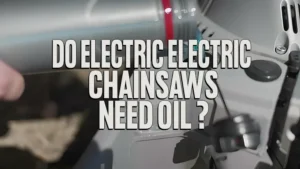






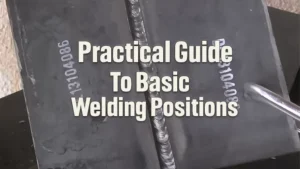
Leave your comment